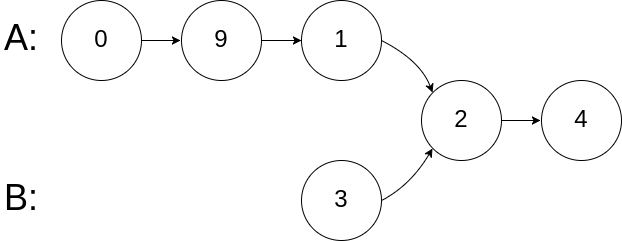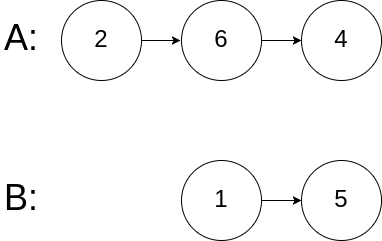给你两个单链表的头节点 headA 和 headB ,请你找出并返回两个单链表相交的起始节点。如果两个链表没有交点,返回 null 。
图示两个链表在节点 c1 开始相交:
题目数据 保证 整个链式结构中不存在环。
注意,函数返回结果后,链表必须 保持其原始结构 。
示例 1:
输入:intersectVal = 8, listA = [4,1,8,4,5], listB = [5,0,1,8,4,5], skipA = 2, skipB = 3 输出:Intersected at '8' 解释:相交节点的值为 8 (注意,如果两个链表相交则不能为 0)。 从各自的表头开始算起,链表 A 为 [4,1,8,4,5],链表 B 为 [5,0,1,8,4,5]。 在 A 中,相交节点前有 2 个节点;在 B 中,相交节点前有 3 个节点。
示例 2:
输入:intersectVal = 2, listA = [0,9,1,2,4], listB = [3,2,4], skipA = 3, skipB = 1 输出:Intersected at '2' 解释:相交节点的值为 2 (注意,如果两个链表相交则不能为 0)。 从各自的表头开始算起,链表 A 为 [0,9,1,2,4],链表 B 为 [3,2,4]。 在 A 中,相交节点前有 3 个节点;在 B 中,相交节点前有 1 个节点。
示例 3:
输入:intersectVal = 0, listA = [2,6,4], listB = [1,5], skipA = 3, skipB = 2 输出:null 解释:从各自的表头开始算起,链表 A 为 [2,6,4],链表 B 为 [1,5]。 由于这两个链表不相交,所以 intersectVal 必须为 0,而 skipA 和 skipB 可以是任意值。 这两个链表不相交,因此返回 null 。
package com.example.lettcode.dailyexercises;
import java.util.HashSet;
import java.util.Set;
/**
* @Class GetIntersectionNode
* @Description 160 相交链表
* @Author
* @Date 2021/6/4
**/
public class GetIntersectionNode {
static class ListNode {
int val;
ListNode next;
ListNode(int x) {
val = x;
next = null;
}
}
/**
* 方法1:两个指针将两个链表遍历一遍,如果中途相遇,说明相遇节点就是相交节点
*
* @param headA
* @param headB
* @return
*/
public static ListNode getIntersectionNode01(ListNode headA, ListNode headB) {
if (headA == null || headB == null) return null;
ListNode pA = headA, pB = headB;
while (pA != pB) {
pA = pA == null ? headB : pA.next;
pB = pB == null ? headA : pB.next;
}
return pA;
}
/**
* 方法2:先找出长度较长的链表,然后指向较长链表的指针先走若干步,使得两个链表后续未遍历的长度相等
* 超时
*
* @param headA
* @param headB
* @return
*/
public static ListNode getIntersectionNode(ListNode headA, ListNode headB) {
if (headA == null || headB == null) return null;
int lenA = 0;
ListNode listNodeA = headA;
while (listNodeA != null) {
listNodeA = listNodeA.next;
lenA++;
}
int lenB = 0;
ListNode listNodeB = headB;
while (listNodeB != null) {
listNodeB = listNodeB.next;
lenB++;
}
ListNode listNodeF = lenA >= lenB ? headA : headB;
ListNode listNodeS = lenA >= lenB ? headB : headA;
int len = lenA >= lenB ? lenA - lenB : lenB - lenA;
while (len != 0 && listNodeF != null) {
listNodeF = listNodeF.next;
len--;
}
while (listNodeF != null && listNodeS != null) {
// 应该是判断两个节点是否指向同一位置,而不仅判断两者元素值
if (listNodeF == listNodeS) return listNodeF;
listNodeF = listNodeF.next;
listNodeS = listNodeS.next;
}
return null;
}
}
// 测试用例
public static void main(String[] args) {
// intersectVal = 8, listA = [4,1,8,4,5], listB = [5,0,1,8,4,5], skipA = 2, skipB = 3
ListNode headA = new ListNode(4);
ListNode listNodeA1 = new ListNode(1);
headA.next = listNodeA1;
ListNode listNodeA2 = new ListNode(8);
listNodeA1.next = listNodeA2;
ListNode listNodeA3 = new ListNode(4);
listNodeA2.next = listNodeA3;
ListNode listNodeA4 = new ListNode(5);
listNodeA3.next = listNodeA4;
ListNode headB = new ListNode(5);
ListNode listNodeB1 = new ListNode(0);
headB.next = listNodeB1;
ListNode listNodeB2 = new ListNode(1);
listNodeB1.next = listNodeB2;
ListNode listNodeB3 = new ListNode(8);
listNodeB2.next = listNodeB3;
ListNode listNodeB4 = new ListNode(4);
listNodeB3.next = listNodeB4;
ListNode listNodeB5 = new ListNode(5);
listNodeB4.next = listNodeB5;
ListNode listNode = GetIntersectionNode.getIntersectionNode(headA, headB);
System.out.print("GetIntersectionNode demo01 result : ");
if (listNode != null) {
System.out.println(listNode.val);
} else {
System.out.println("NO found intersectionNode!!");
}
// 0,9,1,2,4], listB = [3,2,4
headA = new ListNode(0);
listNodeA1 = new ListNode(9);
headA.next = listNodeA1;
listNodeA2 = new ListNode(1);
listNodeA1.next = listNodeA2;
listNodeA3 = new ListNode(2);
listNodeA2.next = listNodeA3;
listNodeA4 = new ListNode(4);
listNodeA3.next = listNodeA4;
headB = new ListNode(3);
listNodeB1 = new ListNode(2);
headB.next = listNodeB1;
listNodeB2 = new ListNode(4);
listNodeB1.next = listNodeB2;
listNode = GetIntersectionNode.getIntersectionNode(headA, headB);
System.out.print("GetIntersectionNode demo02 result : ");
if (listNode != null) {
System.out.println(listNode.val);
} else {
System.out.println("NO found intersectionNode!!");
}
// [2,6,4], listB = [1,5]
headA = new ListNode(2);
listNodeA1 = new ListNode(6);
headA.next = listNodeA1;
listNodeA2 = new ListNode(4);
listNodeA1.next = listNodeA2;
headB = new ListNode(1);
listNodeB1 = new ListNode(5);
headB.next = listNodeB1;
listNode = GetIntersectionNode.getIntersectionNode(headA, headB);
System.out.print("GetIntersectionNode demo03 result : ");
if (listNode != null) {
System.out.println(listNode.val);
} else {
System.out.println("NO found intersectionNode!!");
}
}



